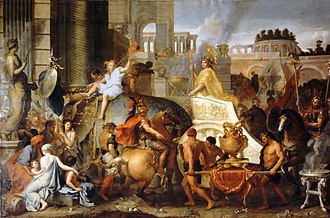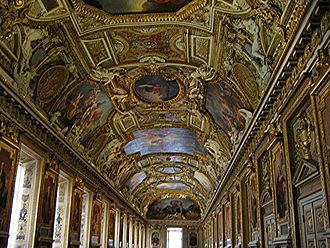Charles Le Brun
Charles Le Brun (also written Lebrun or LeBrun ) (born February 24, 1619 in Paris ; † February 12, 1690 in Paris) was a French painter, architect, ornament draftsman, court painter (1662), director of the tapestry manufactory as well as rector and chancellor the Académie royale de peinture et de sculpture . He was in charge of furnishing the Vaux-le-Vicomte and Versailles castles and was one of the most important and formative artists of the Louis XIV style.
Life
Le Brun came from a family of sculptors who were probably of Scottish origin. His father Nicolas Le Brun (died 1648) taught his son the basics of sculpture and drawing. Charles, like his brothers Nicolas (1615–1660) and Gabriel (1625–1660), did not turn to his father's profession, but to painting, in which he showed some talent.
From 1632, international studies, first employment
A pen drawing by the 13-year-old that Ludwig XIII. on horseback, made the Chancellor Ségnier (partly Séguier ) aware of Le Brun. Ségnier recognized the boy's talent, took him in and gave him an education. Le Brun studied painting under François Perrier , known as the Burgundy, in 1632 and under Simon Vouet in 1634/1637 , with whom he trained primarily at the collection of antiquities and the collection of Italian masters in Fontainebleau Palace .
As early as 1638 he was Peintre du Roi ("royal painter") and received his first commissions from Cardinal Richelieu , who was very impressed by the work of the young artist.
His patron Ségnier made it possible for Le Brun to go to Rome in 1642 to study with Poussin , who received him very kindly. In addition, Le Brun received a pension of 200 Ecus from Ségnier. In Rome he drew especially after the ancient sculptures, but also devoted himself to the works of Carracci , Raffael and Guido Reni , who had a strong influence on Lebrun's later work. When he returned to France in 1646, he had long been famous there for the work he had sent home and received numerous commissions for the design of private houses such as the Hôtel Lambert in Paris (Hercules saga, Pan and Bacchus), but also for altars - and other church paintings.
In 1647 he married the daughter of the court painter Butay.
From 1648, at the Royal Academy
In 1648 he was a co-founder of the Académie royale de peinture et de sculpture , to which he remained lifelong. From 1657 Nicolas Fouquet , Surintendant des Finances , became his patron and provided him with a pension of 12,000 livres . Le Brun was director of Fouquet'schen Tapestry - factory in Maincy and started off in 1658 with the decoration of Fouquet's Vaux-le-Vicomte , making him with Louis Le Vau and André Le Nôtre made known. Jules Mazarin introduced it to court in 1660, whereupon he began executing the Alexander cycle , a series of paintings depicting stages in the life of Alexander the great , for the king , and created a painting for the queen mother Anna for her prayer room.
With the violent overthrow of Fouquet by the king in 1661, the artistic triumvirate of Vaux-le-Vicomte changed over to the services of the crown and realized many projects for them together. In Colbert , Le Brun found a new patron who helped him achieve an almost meteoric rise: in 1662 Le Brun was raised to the nobility and appointed Premier Peintre du Roi , the highest official painter's office. A year later, in 1663, he was appointed guard general of the royal collections (about general director) and, at Colbert's instigation, was appointed director of the Manufacture Royale des Tapisseries et Meubles de la Couronne (the state-owned art workshops and manufactories that, in addition to tapestries and furniture, also various others Produced works of art), for which he made numerous designs and whose execution he then supervised. In 1666 he founded the academy's branch in Rome, and in 1668 he became rector and chancellor of the academy. In 1677 he accompanied the king on his campaign in Flanders (against Spanish possessions).
Meanwhile performed numerous works in castles, the decoration of the Apollo Gallery (1661), the Hall of Mirrors (1679) and the Grand Ambassador's Staircase (Grand Escalier des Ambassadeurs, 1674/1678) in Versailles , the decoration of the castle Marly (1683/1686 ) and the decoration of Colbert's Sceaux Castle (1670/1674).
From 1683, after Colbert's death
At the height of his career, Le Brun was the undisputed patron of art - some said that he was an art despot - when Colbert died on September 6, 1683. The death of his benefactor brought the artist's rise to an abrupt end: although he was not abandoned by the king, the royal favor turned now, mainly at the instigation of Louvois , Colbert's successor, to Mignard , who was patronized by Louvois.
Le Brun died at the age of almost seventy-one in Paris.
meaning
Hardly any other artist had shaped an art style as much as Le Brun had shaped the style of Louis XIV. Above all, the great breadth of his work, in addition to paintings and interior decoration, also numerous designs for tapestries such as those from Aubusson and for other decorative ornaments, enabled him to exert this far-reaching influence. Le Brun, who was trained by the Italian masters, left behind a work that was repeatedly exemplary for the following generations of French courtly art in its stringency and solemn dignity. With the increasing playfulness of the décor in the 18th century, the art debate of the time began to think back to the grand siècle (the “great century” under Louis XIV), whose art production idealized as “true French art” and as a counterpart to the "Ornamental Schwulst" was understood.
Works
- Concise dictionary of soul grinding: for non-profit use, especially for draftsmen, painters and lovers of characteristic and allegorical representations; with 52 heads engraved in copper, concerning the most excellent emotions and passions . Kleefeld, Leipzig 1802 ( digitized edition of the University and State Library Düsseldorf )
literature
sorted alphabetically by author
- Emile Bellier de La Chavignerie: Charles Lebrun. In: Dictionnaire général des artistes de l'école française depuis l'origine des arts du dessin jusqu'à nos jours. Renouard, Paris 1882-1887; ND: Garland Publishing Inc., New York, London 1979, p. 994.
- Wolf Burchard: The Sovereign Artist: Charles Le Brun and the Image of Louis XIV. Paul Holberton Publishing, 2016. ISBN 1911300059
- Château de Versailles (ed.): Charles Le Brun 1619-1690, peintre et dessinateur . 1963 (exhibition catalog).
- Michel Gareau: Charles Le Brun, First Painter to King Louis XIV . Harry N. Abrams, New York 1992, ISBN 978-0-81093567-9
- Pierre Marcel: Charles Le Brun - Maîtres de l'art. Plon-Nourrit et Cie, Paris, 1909.
- Georg Kaspar Nagler : Charles Le Brun. In: Neues Allgemeine Künstler-Lexicon , Volume 2, p. 163 ff. Verlag von E .A. Fleischmann, Munich 1835.
- Pablo Schneider: The first cause: art, representation and science in the times of Louis XIV and Charles Le Bruns. Mann, Berlin 2011, ISBN 978-3-78612632-4 .
- Pablo Schneider: The composite world of the Parterre d'Eau in the gardens of Versailles 1672–1683. Charles Le Brun in the field of tension between art and science . In: Die Gartenkunst 12 (2/2000), pp. 257–274.
- Giancarlo Sestieri: Battle Painters. Italian and Foreign Masters of the XVII and XVIII centuries . Rome 1999.
- Fabian Stein: Charles LeBrun: La tenture de l'Histoire du Roy = manuscripts for art history in the Werner publishing company 4). Wernersche Verlagsgesellschaft , Worms 1985, ISBN 978-3-88462-904-8
Web links
- Literature by and about Charles Le Brun in the catalog of the German National Library
- Works by and about Charles Le Brun in the German Digital Library
- Lebrun, Charles . In: Meyers Konversations-Lexikon . 4th edition. Volume 10, Verlag des Bibliographisches Institut, Leipzig / Vienna 1885–1892, p. 601.
- Le Brun, the accademist. In: charleslebrun.com. (English).
- Jutta Duhm-Heitzmann: February 12, 1690 - anniversary of the death of Charles Le Brun WDR ZeitZeichen on February 12, 2020 (podcast)
| personal data | |
|---|---|
| SURNAME | Le Brun, Charles |
| ALTERNATIVE NAMES | Lebrun, Charles; Brun, Charles le |
| BRIEF DESCRIPTION | French painter and ornament maker |
| DATE OF BIRTH | February 24, 1619 |
| PLACE OF BIRTH | Paris |
| DATE OF DEATH | February 12, 1690 |
| Place of death | Paris |



